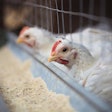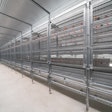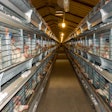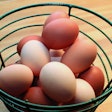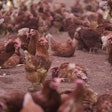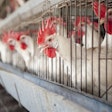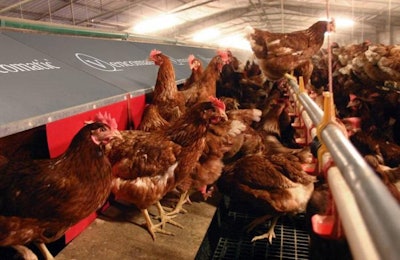
Floor systems are a good choice for farmers who want to go cage-free but are dealing with space or financial constraints. However, due to the system’s single-tier layout, it is the least effective cage-free system in terms the number of birds it can house.
The U.S. egg industry is rapidly scaling up its cage-free egg production to meet customer demand for the product. Egg Industry is publishing a series of articles discussing the pros and cons of three types of cage-free housing systems: aviaries, floor systems and combination, or combi, systems. This article focuses on floor systems.
Egg Industry surveyed cage-free housing manufacturers from around the world to gather input on their systems. Big Dutchman Inc., Farm Innovation Team GmbH (FIT), Jansen Poultry Equipment, Valco Companies Inc./Valli Spa, Potter’s Poultry International, Tecno Poultry Systems LLC, Vencomatic Group, Hellmann Poultry GmbH & Co. KG and Farmer Automatic Gmbh & Co. KG, responded to the survey.
What a floor system looks like
Floor systems, also referred to as a nest and slats system, is composed of a row, or multiple rows, of nest boxes situated at the top of a downward sloping, or sometimes horizontal, set of slats. An egg belt installed underneath the nest boxes collects the eggs. The slats allow for manure to drop to the bottom of the house and be collected manually or by a manure belt or scraper system.
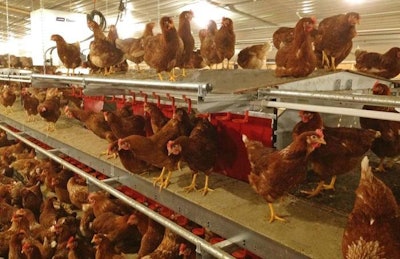
Floor systems are also known as nest and slat systems because they are often composed of a series of laying nests situated on top of slats, which allow droppings to be collected below the system, and a litter area. | Vencomatic Group
Systems vary depending on the manufacturer and the farmer’s needs, but typically a litter or open floor area is set up along the edges of the barn to accommodate bird behaviors like scratching and dust bathing. Feed belts and drinkers are set up in the slat area and perches can be installed on top of the nest boxes or in the slat area. Many systems feature technology to keep birds from roosting inside the nest at night.
The most “cage-free” option
The majority of the suppliers who replied to Egg Industry’s survey said they sell these systems. Only German manufacturer Farmer Automatic and Italian company Tecno Poultry said they do not sell floor and nest systems.
The suppliers said the floor system is ideal for farmers who are dealing with space constraints inside their houses. Because of the slat design, the system can work well in conventional to cage-free conversions because it can take advantage of existing a conventional egg operation manure management infrastructure.
The floor system is free of any type of confinement, which is an advantage for farmers who want to provide the most freedom of movement. Costs vary, but typically the system is cheaper than comparable cage-free systems and it can be easier to manage, as well.
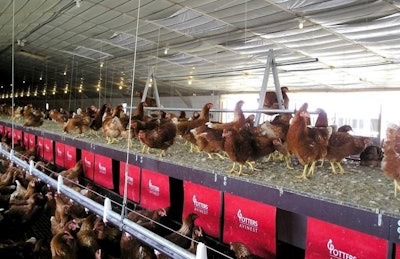
Floor systems are thought to be the most aesthetically pleasing option because they do not confine the birds in any way. | Potters Poultry
Potter’s, based in Rugby, U.K., said the system’s open layout works well with low barn ceilings, makes management of the flock easier – because workers can see where all of the birds are at all times – and it’s visually appealing to farmers, possibly running organic operations, who want to simulate a free-range environment inside their house or provide outdoor access. Vencomatic, of Eersel, Netherlands, said floor systems are ideal for farmers who are switching from a broiler facility to a layer house, or are working in a smaller house with a smaller flock.
The system can also bring animal welfare advantages. Jansen, based in Barneveld, Netherlands, said the slats offer solid support and grip for birds feet while reducing their exposure to droppings and dust.
“Good manure passage allows hygienic conditions and, therefore, contributes to clean slats and nests, and clean nests also means clean eggs,” Jansen said in its reply.
Because the system features no confinement, nest and slat houses shouldn’t have to worry about being rejected by the welfare certifying bodies. The major certifiers, Humane Farm Animal Care, the American Humane Association and the United Egg Producers do not have any reservations regarding floor housing system.
Space tradeoffs
Floor systems don’t offer the stocking density advantages of the aviary or convertible housing systems. Additionally, it is not the best investment for farmers who are building new houses because it cannot take full advantage of vertical space inside the chicken house.
German manufacturers FIT, based in Steinfurt, and Hellmann, based in Vechta, said the space limitations are serious. Hellmann said the house’s floor surface area must be twice as large as a house using an aviary in order to house the same number of birds. Because of the horizontal layout, stocking density must be much lower as well.
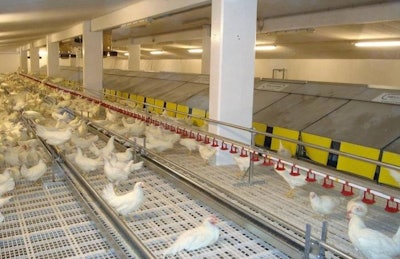
Floor systems are the best option for houses dealing with vertical space constraints. | Hellmann Poultry
Potters said the manure storage system can lead to some issues with vermin.
“Anytime you are using raised slats and there are areas inside the barn where birds are unable to move through (i.e., under the slats), manure will build up, and provide more possible areas for rats and mice (Salmonella vectors) to live,” Potters said in its reply.
Due to these constraints, the floor system is not as popular with egg farmers as the aviary or convertible cage-free housing options, according to the manufacturers.




